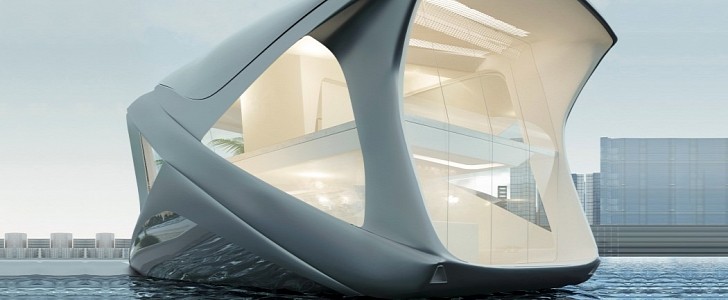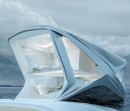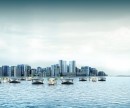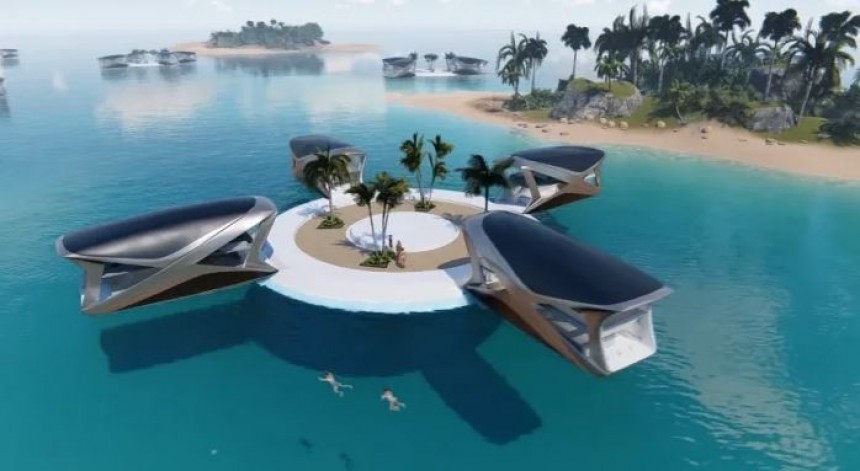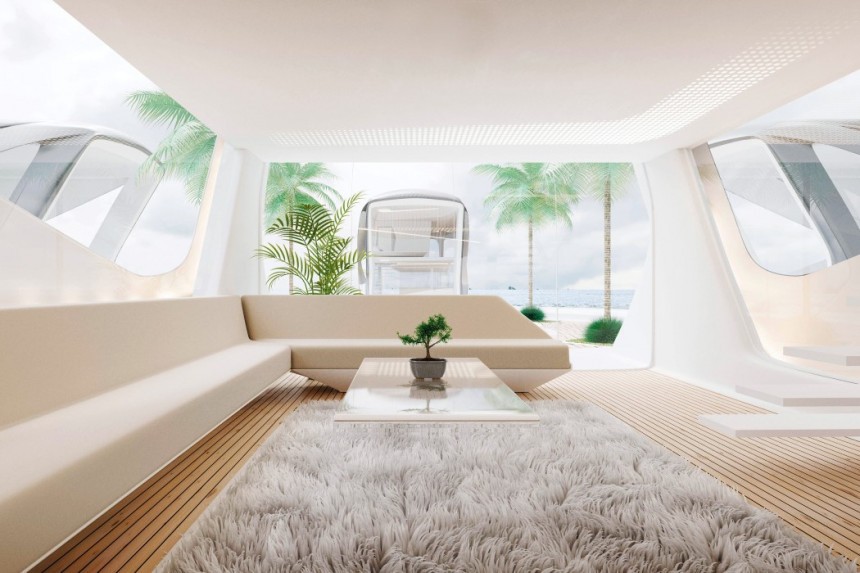Any half-decent near- or post-apocalyptic movie imagines the world of tomorrow as something out of Mad Max. With all the basics gone, what sense is there for comfort, let alone luxury?
This project doesn’t go that far into the future, but it still imagines a bleak one. And it fights back against it with an elegant solution, a visually striking and possibly quite luxurious floating house. The project in question is called Ocean Community, and it’s the work of Wojciech Morszty, a designer and student with London’s Royal College of Arts.
We spoke briefly about Ocean Community before. In 2019, it was recognized with the Red Dot Top Design Award in Transportation / Other Transportation Design. This wasn’t the first time that Morszty received peer recognition, but it was a project that stood out from everything else.
In the past couple of years, interest in this type of floating structure has increased exponentially. Call them floating homes, house yachts or boathouses, but they all aim to offer a solution to rising sea levels by allowing humans to relocate at sea – as many times as need be. In the context of global warming and negative feedback from researchers on how sea levels will rise dangerously if we don’t immediately lower our carbon footprint, even real estate is relocating on water, with the so-called floating islands.
Designers are convinced people in coastal cities have only one hope, short of moving inland: moving out on the water. This is what Ocean Community also suggests, but with a twist.
Unlike other floating homes – take the most recent Arkup 40 as an example – these units are meant to travel by water only over short distances. Their main goal is to extend the coastline out into the ocean, so they will be situated at 800 meters (2,625 feet) away from the shore. This is far enough to create the illusion of living on water, but still close to have quick access to facilities on land.
The name Ocean Community comes from the fact that one “community” consists of four units and a Docking Platform. Morszty doesn’t explain whether the Platform is moored or otherwise fixed into the ocean floor, but he does say that it would supply the four units with fresh water and electricity, as well as recycle waste.
Each unit is a two-level pod for up to two people. It’s furnished in delicate whites and soft colors, with modern finishes and a decidedly minimalist (but cozy) styling. It can open completely on two sides to the outside, offering a very breezy kind of experience. The pun is on purpose: to save up on energy, the units would use wind energy for a natural cooling system.
Solar panels on the roof and batteries would provide electricity to run all necessary appliances. Rainwater would be collected and the water filtration system underneath the floor, which includes storage, would turn it into potable water. In case there’s no rain, freshwater supplies are furnished by the Platform but, again, the designer stops short of elaborating on it.
Moving the units from one location to another would be done by means of an unspecified “autonomous module.” It’s not attached permanently to the unit but it can be “summoned” via an app for a particular use, like a short joyride, or if you need to get on land for an appointment or to run errands. For instance, to keep a gym appointment, you would have to use the app to schedule a time for the autonomous module, which would arrive, hook up to your unit, and ferry you to and from land. The same would happen if you had laundry to be done, needed groceries, or wanted entertainment.
These floating units, Morszty says, could become necessary by 2035 if we don’t do something about global warming, and fast. By then, technology will have advanced sufficiently to make them relatively affordable, so a $200,000 price tag per unit would be possible. Potential for expansion is great, as Ocean Community could work both as private permanent residence and hospitality unit.
For an apocalyptic scenario, this is quite a beautiful house yacht.
We spoke briefly about Ocean Community before. In 2019, it was recognized with the Red Dot Top Design Award in Transportation / Other Transportation Design. This wasn’t the first time that Morszty received peer recognition, but it was a project that stood out from everything else.
In the past couple of years, interest in this type of floating structure has increased exponentially. Call them floating homes, house yachts or boathouses, but they all aim to offer a solution to rising sea levels by allowing humans to relocate at sea – as many times as need be. In the context of global warming and negative feedback from researchers on how sea levels will rise dangerously if we don’t immediately lower our carbon footprint, even real estate is relocating on water, with the so-called floating islands.
Unlike other floating homes – take the most recent Arkup 40 as an example – these units are meant to travel by water only over short distances. Their main goal is to extend the coastline out into the ocean, so they will be situated at 800 meters (2,625 feet) away from the shore. This is far enough to create the illusion of living on water, but still close to have quick access to facilities on land.
The name Ocean Community comes from the fact that one “community” consists of four units and a Docking Platform. Morszty doesn’t explain whether the Platform is moored or otherwise fixed into the ocean floor, but he does say that it would supply the four units with fresh water and electricity, as well as recycle waste.
Each unit is a two-level pod for up to two people. It’s furnished in delicate whites and soft colors, with modern finishes and a decidedly minimalist (but cozy) styling. It can open completely on two sides to the outside, offering a very breezy kind of experience. The pun is on purpose: to save up on energy, the units would use wind energy for a natural cooling system.
Solar panels on the roof and batteries would provide electricity to run all necessary appliances. Rainwater would be collected and the water filtration system underneath the floor, which includes storage, would turn it into potable water. In case there’s no rain, freshwater supplies are furnished by the Platform but, again, the designer stops short of elaborating on it.
These floating units, Morszty says, could become necessary by 2035 if we don’t do something about global warming, and fast. By then, technology will have advanced sufficiently to make them relatively affordable, so a $200,000 price tag per unit would be possible. Potential for expansion is great, as Ocean Community could work both as private permanent residence and hospitality unit.
For an apocalyptic scenario, this is quite a beautiful house yacht.
